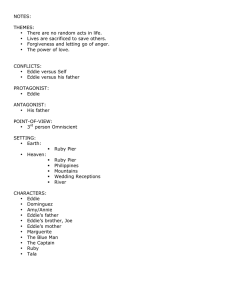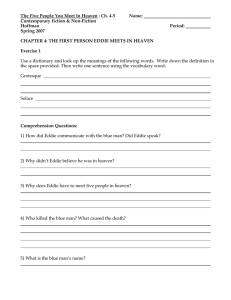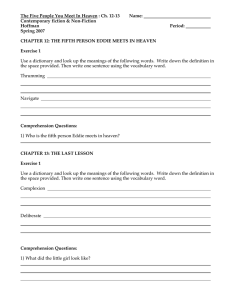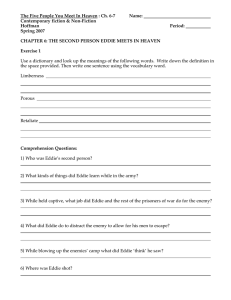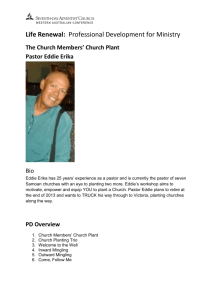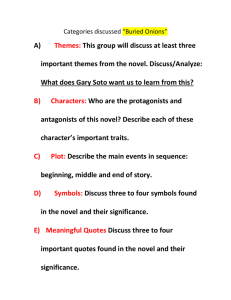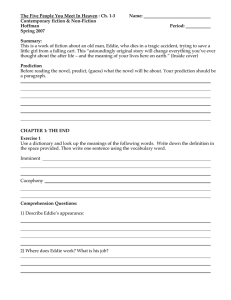I The “Right” Medicine Gabriel T. Verzino ’10
advertisement
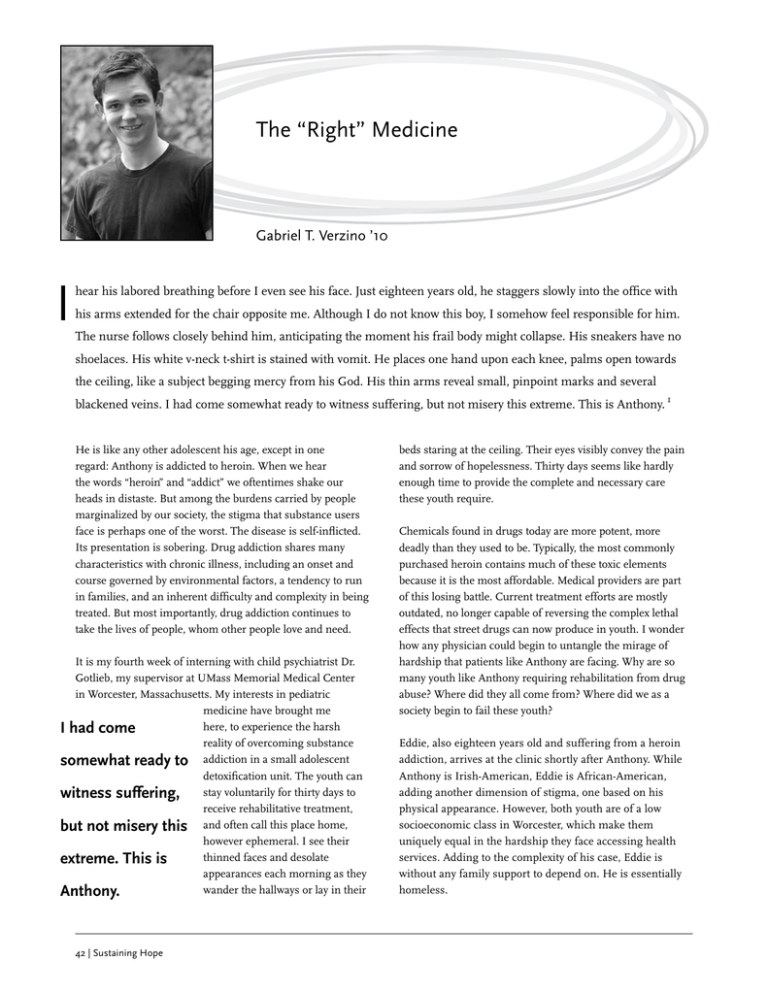
The “Right” Medicine Gabriel T. Verzino ’10 I hear his labored breathing before I even see his face. Just eighteen years old, he staggers slowly into the office with his arms extended for the chair opposite me. Although I do not know this boy, I somehow feel responsible for him. The nurse follows closely behind him, anticipating the moment his frail body might collapse. His sneakers have no shoelaces. His white v-neck t-shirt is stained with vomit. He places one hand upon each knee, palms open towards the ceiling, like a subject begging mercy from his God. His thin arms reveal small, pinpoint marks and several blackened veins. I had come somewhat ready to witness suffering, but not misery this extreme. This is Anthony. 1 He is like any other adolescent his age, except in one regard: Anthony is addicted to heroin. When we hear the words “heroin” and “addict” we oftentimes shake our heads in distaste. But among the burdens carried by people marginalized by our society, the stigma that substance users face is perhaps one of the worst. The disease is self-inflicted. Its presentation is sobering. Drug addiction shares many characteristics with chronic illness, including an onset and course governed by environmental factors, a tendency to run in families, and an inherent difficulty and complexity in being treated. But most importantly, drug addiction continues to take the lives of people, whom other people love and need. It is my fourth week of interning with child psychiatrist Dr. Gotlieb, my supervisor at UMass Memorial Medical Center in Worcester, Massachusetts. My interests in pediatric medicine have brought me here, to experience the harsh I had come reality of overcoming substance somewhat ready to addiction in a small adolescent detoxification unit. The youth can witness suffering, stay voluntarily for thirty days to receive rehabilitative treatment, but not misery this and often call this place home, however ephemeral. I see their thinned faces and desolate extreme. This is appearances each morning as they wander the hallways or lay in their Anthony. 42 | Sustaining Hope beds staring at the ceiling. Their eyes visibly convey the pain and sorrow of hopelessness. Thirty days seems like hardly enough time to provide the complete and necessary care these youth require. Chemicals found in drugs today are more potent, more deadly than they used to be. Typically, the most commonly purchased heroin contains much of these toxic elements because it is the most affordable. Medical providers are part of this losing battle. Current treatment efforts are mostly outdated, no longer capable of reversing the complex lethal effects that street drugs can now produce in youth. I wonder how any physician could begin to untangle the mirage of hardship that patients like Anthony are facing. Why are so many youth like Anthony requiring rehabilitation from drug abuse? Where did they all come from? Where did we as a society begin to fail these youth? Eddie, also eighteen years old and suffering from a heroin addiction, arrives at the clinic shortly after Anthony. While Anthony is Irish-American, Eddie is African-American, adding another dimension of stigma, one based on his physical appearance. However, both youth are of a low socioeconomic class in Worcester, which make them uniquely equal in the hardship they face accessing health services. Adding to the complexity of his case, Eddie is without any family support to depend on. He is essentially homeless. He remains non-compliant with medical advice, insisting that his present age is proof enough that he can make decisions regarding his own personal health. He says he does not need rehabilitative treatment, yet, I wonder, how can he live safely without a home? Also, his previous arrest for assaulting other students while under the influence of alcohol, a situation which is prototypical for half of most major crimes, connects back to my previous question: can Eddie still have a comfortable and fruitful life in society? Anthony and Eddie are just two of the hundreds of thousands of adolescents addicted to illicit drugs, such as heroin.2 On a typical day in America, 4,348 adolescents will use an illicit drug other than marijuana for the first time.3 During the course of my internship Anthony and Eddie provided a window into the complexities inherent in dealing with this group of troubled youth, such as the environmental factors that propagate drug use and crime rates. Ultimately, our understanding of their lives can help our society in general, and the medical community in particular, address their needs. Anthony: Home, For a Moment Each morning, I arrive to UMass Memorial Medical Center by the commuter rail which leaves promptly from Wellesley, Massachusetts at 7:16 A.M. From the window seat the landscape outside changes dramatically from the affluent suburbs of Wellesley and Natick to the industrial downtown Worcester area. The ease of suburban life marked by centuryold churches with quiet boutiques and café establishments transitions somewhat harshly to the sight of dilapidated tenement apartments guarded behind chain link fences. Once the train arrives in Worcester Station, the air feels heavier, more oppressive, and markedly more polluted. Along cracking sidewalks, battered cars and roaring trucks add a claustrophobic feeling to the crowded streets. The poverty is striking to see, yet it is exactly where I want to be. Conversely, the welcoming essence of UMass Medical School provides a refuge for all patients that arrive there. The once over-used and cracking sidewalks are now comprised of white stone that presses gently against lush green lawns. The campus appears to stretch for miles in front of me – elegant, spacious, and sophisticated. One can admire the words, “The University of Massachusetts Medical School” engraved above the original entrance. Built in 1962, the building reflects a modern yet well-established medical education and research institution. Inside, the medical faculty is equally warm and friendly. Medical residents exchange smiles and occasionally a handshake in the hallways. A group of physicians are engaged in light-hearted conversation. The loudspeaker broadcasts an announcement. A physician uses the land phone in the hallway. A gurney is maneuvered skillfully around a corner by a technician who is simultaneously wheeling several intravenous bags of fluid. This is controlled chaos. The patients, although I cannot be sure exactly how they are feeling, sit quietly relaxed in chairs outside the emergency room. They appear to be relieved from physical pain, but in a way, also seem sheltered from the troubles of their reality outside these walls. Outside the hospital window I can see heat radiating from the hoods of the ambulances and cars parked outside the emergency room. It is mid-June and an oppressively hot day. “They still haven’t fixed the air conditioning system,” says Dr. Gotlieb, as she writes out a script for her last patient on a prescription notepad.4 Ultimately, our understanding of their lives can help our society in general, and the medical “That’s really unfortunate,” I community in reply optimistically. “Maybe it will be fixed tomorrow.” My particular, address collared shirt and tie begin to feel uncomfortable in the heat. their needs. I decide to loosen a top button. The smell of pungent vomit and suboxone medication5 n the narrow hallway outside the office door is more prominent in the heat. But the stench does not bother me. Instead, I am too consumed with excitement and an incredible sense of pride to be learning about substance abuse treatment firsthand. The first thing I learned about substance use rehabilitation in a Disorders of Childhood course last spring at Brandeis University was that addicted youth could be treated with behavior-based therapies. And more importantly that a family-based treatment model that involved parents and extended family was usually the most reliable method of helping a youth to recover.6 The pockets of my black slacks sag under the weight of physicians’ hospital cards, a laminated book of illegal substances, meal tickets, a methadone protocol printout, my commuter-rail ticket, and about two dollars in loose change. As I wait quietly for the next patient to come in, Dr. Gotlieb finishes writing another script. She is from an affluent neighborhood, near my own, but has dedicated her life to treating youth in this clinic. Her nametag hangs slightly sideways on the edge of her shirt collar. Unlike the other physicians, who prominently wear their nametags from International Center for Ethics, Justice, and Public Life | 43 the breast pocket of their scrubs, her character seems less pretentious, governed more by the value of her words than the value of her title. It is refreshing for me to see this as someone coming from an upper-middle class background, where prestige and arrogance is almost commonplace. Her diploma, Yale School of Medicine, is barely visible inside a brown storage box hiding in the corner of her office. “You know,” she says genuinely, “the really difficult part in prescribing medications is that we can never entirely know for sure what compounds are in the street drugs kids are using.” I nod my head while pulling out my laminated book on street drugs. Looking at the pristinely covered front, I find it funny that a book on street drugs has been euphemized in this way. Most drugs are dirty; they are inhaled through pipes or cooked in spoons and injected through syringes. In this book, they seem to be abstract potential dangers, but they are actually commonly found at college parties. Flipping to the corresponding potencies section, I remember sitting in Organic Chemistry lab my sophomore year at Brandeis. The TA is standing at the whiteboard describing the process of mixing a compound in a liquid when he explains that part of the failures of drug control efforts is that drug potency is increasing, contributing to unsafe use.7 “How do you mean?” I ask curiously. Dr. Gotlieb stands up, and tucking several charts under her arm exhales deeply. for a seat in which to rest his worn-out and emaciated body. Anthony peers out into the violent morning sunlight. The light reveals his sunken eyes, deep black circles. He probably has not slept in days. The light is too bright and he turns to stare in my direction. I feel slightly uncomfortable at first, thinking that he may perceive me as a phony intern, one who is too young, but I suddenly suspect that he is not thinking that at all. Although his eyes are locked on me, his mind is elsewhere. Consumed by the pain and sorrow of hopelessness, only his eyes can explain what is happening to him. He is dying inside. It is difficult for me to look away from his gaze. “Have a seat here,” Dr. Gotlieb says kindly. “It’s comfortable.” Yet his anguished face makes it clear that no seat is comfortable enough to subdue the withdrawal he is experiencing. Dr. Gotlieb waits patiently until I am able to break eye contact with Anthony. Her expression is controlled, and experienced. Mine is probably horrified. I give a millisecond smile and shift in my seat, clearing my throat. The assessment continues. “Anthony, the nurses told me you came in last night,” she begins softly, calculated. “Yeah,” he manages to say. I catch a glimpse of his thoroughly dried out tongue. “Well, the seller makes more money by cutting the drug with other household products, like detergent and dishwasher soap,” she glances quickly at the clock on the wall, “But that punishes the user by making drug dosages less safe and predictable.” She speaks eloquently, as if she is reading something from a medical textbook. For a moment, I pretend to be a medical school student. “Well there are not many other youth on the floor this month, so I think you’ll be able to settle in nicely,” she tells him optimistically. Anthony doesn’t seem focused on what Dr. Gotlieb has to say, much less on the conditions of his new living arrangements for the month. Without moving her head away from Anthony, she peers at me quickly, and then back towards his direction, perhaps assessing the impact he is making on me. “OK, well you can ask the next patient questions if you have any,” she says, rushed. I had never done a psychiatric intake before. “I’ll go get his chart and then bring him back.” “How are you feeling?” she asks, now concerned with his apparent lack of mental wherewithal. His lips are cracked and bleeding as he breathes in deeply to answer. This patient might very well my very first diagnosis, I think to myself. But who will it be? I wonder. The youth on this floor typically range in age from 16 to 21. It is only on rare occasions, like yesterday, when a girl from Gloucester, just 14, was admitted for using heroin by skin-popping.8 With as much knowledge as an undergraduate could have about substance abuse, I feel intellectually prepared, but apparently, not emotionally prepared to see Anthony. “Like crap,” he speaks slowly. He begins wheezing and it seems like what he really needs is medicine, not a conversation. After waiting patiently in a metal folding chair, Anthony suddenly comes staggering into the room, arms extending 44 | Sustaining Hope Interestingly, a while back, when I was reviewing articles for the purposes of writing a clinical review paper with Dr. Gotlieb, I learned that youth who use heroin are typically treated with other medications, even additional opiates.9 This treatment process is known as methadone maintenance, which provides smaller and smaller doses of “controlled” opiates, like suboxone, to wean youth off their addiction and lessen their painful side effects of withdrawal. According to these studies, however, the process is typically achieved within a 9- to 12-week period.10 Thus, even if Anthony did eventually receive methadone maintenance, it was unlikely that a thirty-day program would be enough time for him to fully recover. Dr. Gotlieb looks at me, anticipating the questions I might ask. But I cannot bring myself to express my concern and thoughts. I am at a loss for words. As Dr. Gotlieb begins speaking again he grimaces in pain. “It says you live with your mother, Kathy, is that right?” she asks, turning back from his chart open on her desk. His hands suddenly begin shaking. When he sees me glance at his hands, he looks down at them as well, as if he feels embarrassed. He clasps his hands together to try to stop them from trembling. Then looking up at me again, a small tear begins to form below his eyelid. “My Mm...Mom” he stammers, distraught with sadness, “My Mom, sh…she doesn’t want me back anymore,” he utters, tears rolling down his freckled face, “Sh…She told me that.” It is a sorrowful sight. His eyes well up with tears, accenting his green eyes. Plopping his face into his hands, he releases a soft but chilling groan, which conveys the true magnitude of his suffering. The abandonment that Anthony feels is not uncommon among addicted youth in our society. From another course I took at Brandeis, Health, Community and Sociology, we read an article describing the feelings of “shame” that parents of addicted youth feel amongst other parents in their society.11 Substance-abusing youth often feel isolated. They are typically ostracized by family and neighbors. People instruct their children to stay away from them. But more importantly, the parents of addicted youth also experience stigma when dealing with their child’s school, the police, and the justice system. These parents typically feel ignored, blamed and de-valued as responsible mentors, creating a sense of hopelessness and frustration, which prevents them from responding appropriately to their child’s drug use. It is possible that Anthony’s mother never wanted him back for these reasons. As Anthony sobs, his right elbow pinches his shirt downwards. It brings his v-neck lower and exposes a cross on a chain around his neck. Where is God here? I wonder. Anthony suffers all alone, without any social supports. But perhaps God is still watching over him. I think of my grandmother, also Irish Catholic, and remember her saying to me in her Irish brogue several weeks before she passed away “The eyes of the Lord are in every place.” Although I cannot be sure, Anthony’s faith affirms that he is being looked after despite the painful circumstances that now surround his life. The anticipation I was previously feeling turns into a Anthony’s visible grief sober frustration. becomes too much to watch. Intense grief and compassion What is there begins bubbling up inside me all at once. I want to do for me to do, I more. But how can I reach out to him? The truly frustrating wonder? My heart reality is that there are many more youth like Anthony; is smashed, but the average heroin addict today is a middle-class, white surely no more teenager. 12 Perhaps even more discouraging, the retail and than the heart of wholesale prices of heroin have decreased dramatically since this boy. the 1990s, thereby increasing heroin availability among youth. 13 The teens at the detoxification center informed me that one could purchase a gram of heroin called “black tar” for roughly $15, and if injected intravenously, it would provide “the best bang for your buck.” 14 Unfortunately, the reason “black tar” is so inexpensive is because it is usually cut with other compounds, such as sugar, starch, powdered milk, quinine, and even poisons like strychnine. 15 The risk of overdose or death is possible because heroin addicts often do not know the actual strength of the drug or its true contents. It is a wonder that Anthony is still alive, I think to myself. The anticipation I was previously feeling turns into a sober frustration. What is there for me to do, I wonder? My heart is smashed, but surely no more than the heart of this boy. Eddie: The Customer Is Always Right Eddie sits in the waiting room of the psychiatry department. He wears baggy dark jeans and a black t-shirt. Eddie is eighteen years old and also a heroin addict, much like Anthony, although with one major difference; he is Black. Many people are aware that male gender is a prominent risk factor for violence and homicide. Additionally, from a medical ethics course at Brandeis, Patient Autonomy, I learned that race itself is also a prominent risk factor for violence. Violence is common in inner city neighborhoods such as those Eddie and Anthony both used to call home. Violence-exposure among youth is among the most powerful risk factors for substance use disorders, tripling the risk of substance use and abuse.16 In such communities, vulnerable International Center for Ethics, Justice, and Public Life | 45 youth may attempt to reconstruct their sense of safety by self-medicating with drugs or alcohol. The slippery slope to addiction is a real threat for youth like Eddie, considering the leading cause of death among Black males between 15 and 24 years of age in the United States is homicide.17 dealing immediately comes to mind, which places Eddie at further risk of involvement with the police. Not to mention, Eddie will also find it difficult to get proper food and sleep safely, exacerbating his risk of malnutrition and mental illness. As I flip to Eddie’s history in his chart, I fear that he was exposed to serious violence sometime prior to arriving at the detoxification unit at UMass Memorial Medical Center. But Eddie left home voluntarily. Contrasting with the counterculture mentality of hippie youth in the 1960s and 1970s who abandoned home in hopes of establishing new values and lifestyles, few youth today are leaving home for these reasons. Most youth today leave home due to physical abuse or substance-abusing parents.22 Eddie reports running away because of the physical abuse he experienced. Taking a seat at the boardroom table, I realize that ditching home was perhaps the only option Eddie had left. Who can blame Eddie for abandoning his family? My own impression of family is completely different from both the counterculture mentality of the 1960s and Eddie’s notion of home. I see my home as a safe-haven. A place where my brothers can feel supported and loved by my parents. My mother, in her Irish way, encourages imagination and light-hearted debates. My father mentions time and time again the importance of an appetite for adventure over the love of ease. Together, my parents engrain in us a predominance of courage over timidity. Contrarily, Eddie feels threatened in his home. Eddie only learns to share the same addiction his father faces, and the ensuing fears and suffering that it creates. However dissimilar our experiences seem, I still hope that Eddie could perhaps find a temporary shelter within the protected walls of UMass Memorial Medical Center. It reads: Eddie was admitted Wednesday (7/15/2009)... recalcitrant to drug use termination, wants to “do own thing” and claims that “weed is God’s plant”… very disobedient, has been arrested twice for assaulting schoolmates… traumatic experiences of domestic violence and physical assault since 14 years old, father has history of drug use and depression… self-medicating with heroin, reports sniffing Percocet in bathroom… no support system at home. 18 My fears are confirmed. Eddie is a victim of domestic violence. It remains unclear, however, whether his experience with physical assault is the only driving force behind his addiction. A few days prior, Dr. Gotlieb highlighted the relationship between child abuse and subsequent substance use in children in one renowned study that interviewed 4,023 adolescents nationally between the ages of 12 and 17 years on their experiences with substance use and victimization experiences.19 The major finding was that adolescents who are physically assaulted or who witness violence have an increased risk for current substance abuse and dependence. I sense that this finding may be pertinent to the addiction that Eddie now faces. The chart also reveals another common antecedent to substance dependence. Eddie reports witnessing his father abuse drugs for several years. Roughly 5.4 million other children under 18 years of age also live with a father who meets the criteria for substance dependence or abuse. 20,21 Parental substance use has a profound impact on children, including child abuse and neglect, and increases the odds that the children will become substance users themselves. It is estimated that roughly 8.3 million children under 18 years of age live with one or more parents with alcohol or illicit drug addictions. I continue glancing between Eddie and his chart. The words “Conduct Disorder” at the bottom of the page suddenly grab my attention. Eddie fit the criteria of this disorder almost perfectly: an unwillingness to obey authority, disruptive behavior, and harming or threatening to harm other people.23 Given his attitude, it seems likely that Eddie may want nothing to with these hospital services or what physicians have to tell him. I have it easy. Being raised in the ease and comfort that filled my childhood, I realize that perhaps I grew up trusting other people too much. But Eddie is not fortunate enough to come from such a loving family and an affluent neighborhood. His father, the person who is supposed to love him most, physically assaults him daily. Thus, Eddie had grown up believing that he could not trust other people. I wonder where Eddie could possibly be tomorrow as I stand staring at him through the Plexiglas window in the psychiatry board room. Eddie is essentially an orphan. Exactly what home could he go back to? Among the many hazards of being homeless, Eddie faces the possibility of being further manipulated by others – doing things against his will in order to survive. The continuation of assaulting others and drug The testimonies that Eddie gives about assaulting other students and his consequent confrontations with law enforcement advance the possibility that Eddie is caught in a vicious pattern of committing crime and using drugs. Among major crimes in the United States, nearly half are committed by perpetrators who are under the influence of illicit drugs.24 Ironically, Eddie takes a personal liberty in disrespecting 46 | Sustaining Hope other people’s freedom, but it is this personal choice that lands him in jail, thereby further suppressing his freedom. Moreover, Eddie now has a criminal record, which will prevent him from obtaining some form of employment.25 This reality will only make Eddie feel more hopeless, further exacerbating his drug use. At eighteen years old, society automatically expects Eddie to assume more responsibility for his actions. If he is found guilty of another crime he will be tried as an adult. Is Eddie mature enough to understand this consequence? He is also legally able to make healthcare decisions on his own behalf. But is Eddie willing to accept this important responsibility? For better or worse, eighteen year old patients, like Eddie, can decide on the treatments they do and do not want, regardless of what the medical provider believes is appropriate. However, it is difficult for me to allow Eddie to continue leading a selfdestructive lifestyle. I wonder how physicians can live with themselves knowing that they allowed another sick patient to leave the hospital. Eddie left the clinic a week later. Medicine Only Goes So Far In the cafeteria one August afternoon, towards the end of my internship, I was having a conversation with Julia, a twentyfour-year-old UMass Medical student. “If you’re great at soaking up small details,” she says positively, “then you’ll survive medical school, no problem.” Julia is in her medical student mode: personable, rushed, and constantly clarifying herself. “I mean, obviously you have to understand the biology and interactions between the organs,” she continues, “And memorize the endless diagnostic protocols and treatment regimes, but that just takes practice.” She is beginning to scare me. “Yeah, obviously,” I reply, trying to sound confident. When the time comes for me to continue finding articles in the library and for her to collect another urine sample, we begin walking towards the exit. She bites into an apple. “It doesn’t matter what you know though,” she mumbles mid-chew, “Patients are going to do what they want to anyways.” She chucks her apple into the trash, and holding her stethoscope tightly around her neck she turns the corner and disappears into the hallway. Eddie had left the hospital in July, perhaps never to return again. But standing at the entrance of the cafeteria, I wondered, ‘Was there something more I could have done?’ And even if Eddie had fully recovered from his addiction, who was to say that he would not continuing using again at some later point? And nobody could be sure whether the treatment Anthony was provided would be his foundation for a more meaningful life. Medicine can heal track wounds and bring addicts back to wellbeing again, but it cannot heal the addiction. The addiction is healed by the patient. By the time I returned home to Wellesley on my final day of interning, it became apparent that compliance is just another aspect of medicine physicians have no control over. But standing at the entrance of the cafeteria, I wondered, ‘Was there something more I could have done?’ Moving Forward Adolescents in inner-city neighborhoods face an incredible burden of street violence and risk the possibility of developing substance use disorders. Anthony and Eddie happen to be just two of the many American youth who live in such neighborhoods. They are marginalized simply because they are of a low socioeconomic status. Eddie continues to face a disproportionate risk of being murdered and using substances just because he is Black. It remains unclear whether medicine can reverse the pain and suffering that these two boys face daily. Would thirty days be enough time for Anthony to recover? Was treatment really appropriate for Eddie? Nobody can be sure. But nobody can be certain when another eighteen-year-old boy from Massachusetts will come staggering into a detoxification clinic with a heroin addiction. Instead of wondering where they came from, we begin to pick up the shattered pieces of their lives. We have already overlooked possible prevention solutions. These questions must be posed to our entire society. Together we must find where we begin to fail these young adults. We must not allow the stigma and ugliness of drug addiction in youth to force us to turn our heads away in disgust and prevent us from intervening. Their struggles propagate crime, place costly burdens on our healthcare system, and tear at the fabric of what family is supposed to mean in this country. This matter is everybody’s business. Of course, we cannot banish the existence of substance abuse with any program. The potency and availability of street drugs remain a complex problem that neither law nor medicine has been able to control completely. But we can perhaps remember, if only for a time, that substance abuse is a chronic illness, which takes patience and perseverance to overcome. These qualities are not inherent in medicine, which can only work to bind up the physical wounds that addiction has created in youth like Eddie and Anthony. But surely physicians can also strive to ensure that addicted youth foster hopefulness, which is perhaps the best medicine, and inherent only in the human spirit. International Center for Ethics, Justice, and Public Life | 47 Notes 1. To protect the identity of patients and colleagues all names are pseudonyms. 2. The Office of Applied Studies Report “A Day in the Life of American Adolescents: Substance Use Facts,” Substance Abuse and Mental Health Services Administration (2007), http://www. oas.samhsa.gov/2k7/youthFacts/youth.pdf. 3. Ibid. 4. Field Notes, June 16, 2009. Approximately 10:00 A.M. 5. A medication used as an opiate replacement, to wean patients of opiate addictions. 6. Waldron, H. B., Slesnick, N., Brody, J. L., Turner, C. W., Peterson, T. R. 2001. “Treatment outcomes for adolescent substance abuse at 4- and 7-month assessments.” Journal of Consulting and Clinical Psychology 69(5) 802-813. 7. Thornton M. 1998. “The potency of illegal drugs.” The Journal of Drug Issues 28: 725–749. 8. Injection of heroin beneath the skin of the forearm (subcutaneously). 9. The National Institute of Drug Abuse, “Principles of Drug Addiction Treatment: A Research-Based Guide,” U.S. Department of Health and Human Services (1999), http://www. nida.nih.gov/PDF/PODAT/PODAT.pdf. 10. Woody, G. E., Poole, S. A., Subramaniam, G., et al. 2008. “Extended versus short-term buprenorphine-naloxone for treatment of opiod-addicted youth: A randomized trial.” JAMA 300(17): 2003–2011. 11. Barton, Judith A. 1991. “Parental adaptation to adolescent drug abuse: An ethnographic study of role formulation in response to courtesy stigma.” Public Health Nursing 8(1) 39-45. 12. National Institute on Drug Abuse “Drug Abuse And Addiction: One of America’s Most Challenging Public Health Problems,” U.S Department of Health and Human Services (2008) http://www.nida.nih.gov/about/welcome/ aboutdrugabuse/index.html. 13. Ciccarone, D. 2008. “Heroin in brown, black and white: Structural factors and medical consequences in the US heroin market.” International Journal of Drug Policy, 20(3): 277-282 48 | Sustaining Hope 14. Field Notes: July 16, 2009. Roughly 10:30 A.M. 15. Strychnine causes muscular convulsions and eventually death through asphyxia or sheer exhaustion. 16. Kilpatrick, D. G., Acierno, R., Saunders, B., et al. 2000. ‘Risk factors for adolescent substance abuse and dependence data from a national sample.” Journal of Consulting and Clinical Psychology 68(1) 19-30. 17. Rich, J. A. & Grey, C. M. 2005. “Pathways to recurrent trauma among young black men: Traumatic stress, substance use, and the ‘code of the street’.” American Journal of Public Health 95(5) 816-824. 18. Field Notes, July 15, 2009 19. Kilpatrick, D. G., Acierno, R., Saunders, B. (Ibid) 20. National Survey on Drug Use and Health, “The NSDUH Report: Children Living with Substance-Dependent or Substance-Abusing Parents: 2002 to 2007” Substance Abuse and Mental Health Services Administration (2009) http://www. oas.samhsa.gov/2k9/SAparents/SAparents.htm 21. DuRant, R. H., Cadenhead, C., Pendergrast, R. A., Slavens, G., and Linder, C. W. 1994. “Factors associated with the use of violence among urban black adolescents.” American Journal of Public Health 84: 612-617. 22. Smart, R. G. & Ogborne, A. C. 1994. “Street youth in substance abuse treatment: Characteristics and treatment compliance.” Adolescence, 29(115):733-45. 23. National Mental Health Information Center “Children’s Mental Health Facts Children and Adolescents with Conduct Disorder,” United States Department of Health and Human Services (1999) http://mentalhealth.samhsa.gov/publications/ allpubs/Ca-0010/default.asp#top. 24. Horgan, Constance, Skwara, Kathleen C., and Gail Strickler. Substance Abuse: The Nation’s Number One Health Problem, Key Indicators For Policy (Waltham, MA: Schneider Institute for Health Policy, 1993), 44-45. 25. Uggen, Christopher. 2000. “Work as a turning point in the life course of criminals: A duration model of age, employment and recidivism.” American Sociological Review, 67:529-546.

